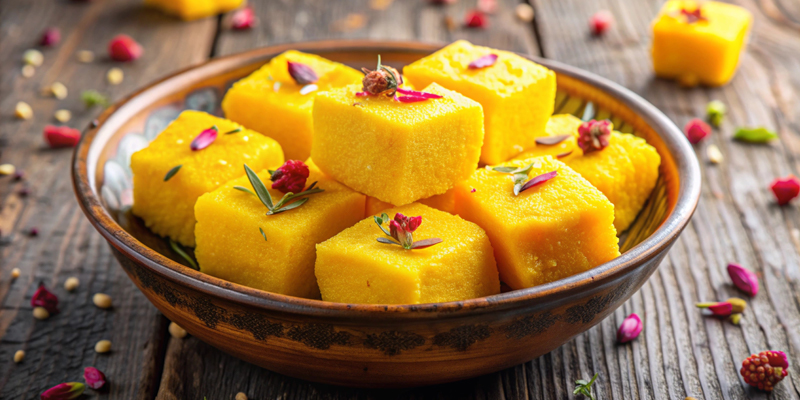
Are you craving for something sweet and comforting? Kesari is the perfect dessert for a delightful indulgence. Originating from South India, this popular dish is known for its rich, buttery texture and sweetness. Whether you’re celebrating a festival or simply want a quick sweet fix, Kesari is your go-to treat.
The best part? It’s as easy to prepare as it is delicious, coming together in just a few minutes.
About the Recipe
Prepared using semolina, sugar and ghee, this delightful dish never fails to impress us. Topped up with dry fruits, it can be consumed both as a breakfast option and as a dessert. The combination of saffron, cardamom, and ghee not only brings out a heavenly aroma but also adds layers of flavor that will have everyone asking for seconds. Plus, the goodness of ghee and semolina makes this dish an ideal choice of nutrition for kids.
There’s more! Kesari is versatile as well as adaptable. While traditionally served as a hot dessert, you can enjoy it cold or even as a mid-day snack. Curious to try this classic dish? The recipe is easy to follow and features ingredients you probably have on hand in your kitchen. Here’s a complete guide to help you bring a taste of India into your kitchen with this deliciously fragrant dessert.
Ingredients
- Ghee- 3 tbsp
- Cashews – 10
- Raisins – 1 tbsp
- Semolina – ½ cup
- Water – 1 cup
- Raw Sugar – 1/4 cup (quantity can be adjusted as per your taste)
- Saffron Water – 2 tbsp
- Cardamom Powder – ¼ tsp
How to Prepare the Authentic Kesari
1. First, heat up the ghee in a pan and toss in the cashews and raisins.
2. Roast them on low flame until the cashews turn golden brown and the raisins puff up. Set them aside, but keep the ghee handy.
3. In the same ghee, add the semolina and roast it gently on low flame for about 5 minutes stirring continuously until it releases a lovely, nutty aroma. Once done, set it aside.
4. Now in a large pan, bring 1 cup of water to a boil. This is the base that will help the semolina cook perfectly.
5. Then, lower the flame and slowly add the roasted semolina to the boiling water.
6. Again stir continuously to ensure there are no lumps. Let the semolina absorb all the water.
7. Keeping the flame low, add the sugar and stir it in until it fully dissolves, creating a smooth, sweet mixture.
8. After that, pour in the saffron water or a bit of yellow food color, giving your Kesari its iconic golden hue. Stir well to combine.
9. Now, add ¼ cup of ghee, and keep stirring to ensure the semolina blends smoothly with the ghee, with no lumps in sight.
10. Cover the pan and let it simmer for 2 minutes on low flame until the semolina is fully cooked and fluffy.
11. Finally, add the roasted cashews, and raisins, and sprinkle the cardamom powder. Mix it all until the Kesari pulls away from the pan.
Serve your Kesari hot, and enjoy its rich, fragrant goodness!
Expert Tips
- Kesari should be cooked on low heat to prevent burning and ensure a smooth texture.
- Use the perfect ratio of 2:1 (water to semolina) for a soft yet firm Kesari. This prevents it from becoming too dry or too sticky, giving you that perfect spoonful every time.
- For a creamier taste, consider replacing water with milk.
- Adjust the sugar to your taste, and feel free to add a pinch of saffron for extra aroma.
Serving Suggestions
- Serve Kesari hot as a dessert or sweet snack.
- You may swap cashews and raisins with almonds, pistachios, or even dried cranberries for a unique twist.
- Pair it with a savory South Indian breakfast like upma or dosa for a balanced meal.
- You can store leftovers in the refrigerator and enjoy them within 2 to 3 days.
FAQs
1. Is it ok to use white sugar instead of raw sugar?
Absolutely! White sugar can be used in equal quantities for a more traditional flavour, though raw sugar gives it a deeper, caramel-like taste.
2. Can I make Kesari vegan?
Yes, simply swap ghee with a plant-based alternative like coconut oil or margarine for a vegan version.
3. Is Kesari suitable for diabetics?
Traditional Kesari is high in sugar, which may not be suitable for diabetics. You can try using sugar substitutes like stevia or monk fruit to make a healthier version.
4. What can I use instead of saffron?
If saffron is unavailable, you can use a pinch of turmeric to give your Kesari its signature golden color.
